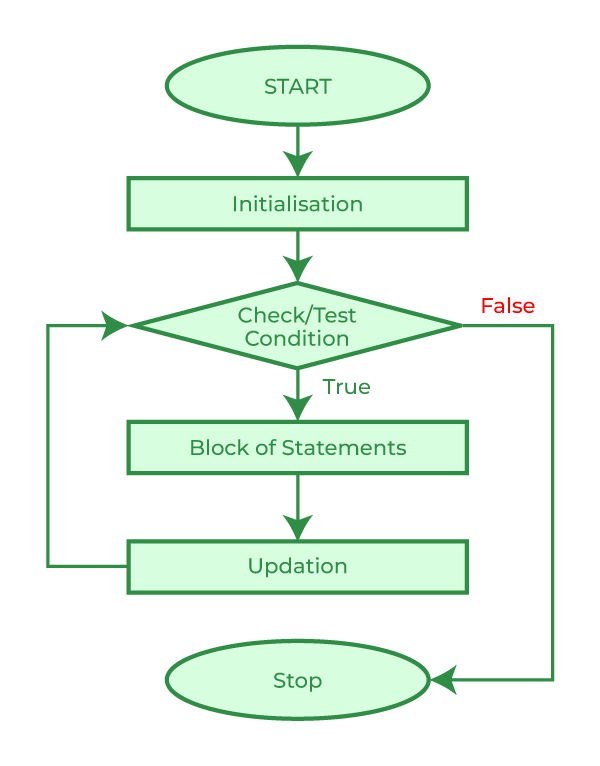C for Loop
Last Updated :
28 Jun, 2023
In C programming, loops are responsible for performing repetitive tasks using a short code block that executes until the condition holds true. In this article, we will learn about for loop in C.
for Loop in C
The for loop in C Language provides a functionality/feature to repeat a set of statements a defined number of times. The for loop is in itself a form of an entry-controlled loop.
Unlike the while loop and do…while loop, the for loop contains the initialization, condition, and updating statements as part of its syntax. It is mainly used to traverse arrays, vectors, and other data structures.
Syntax of for Loop
for(initialization; check/test expression; updation)
{
// body consisting of multiple statements
}
Structure of for Loop
The for loop follows a very structured approach where it begins with initializing a condition then checks the condition and in the end executes conditional statements followed by an updation of values.
- Initialization: This step initializes a loop control variable with an initial value that helps to progress the loop or helps in checking the condition. It acts as the index value when iterating an array or string.
- Check/Test Condition: This step of the for loop defines the condition that determines whether the loop should continue executing or not. The condition is checked before each iteration and if it is true then the iteration of the loop continues otherwise the loop is terminated.
- Body: It is the set of statements i.e. variables, functions, etc that is executed repeatedly till the condition is true. It is enclosed within curly braces { }.
- Updation: This specifies how the loop control variable should be updated after each iteration of the loop. Generally, it is the incrementation (variable++) or decrementation (variable–) of the loop control variable.
How for Loop Works?
The working of for loop is mentioned below:
- Step 1: Initialization is the basic step of for loop this step occurs only once during the start of the loop. During Initialization, variables are declared, or already existing variables are assigned some value.
- Step 2: During the Second Step condition statements are checked and only if the condition is the satisfied loop we can further process otherwise loop is broken.
- Step 3: All the statements inside the loop are executed.
- Step 4: Updating the values of variables has been done as defined in the loop.
Continue to Step 2 till the loop breaks.
Flowchart of for Loop

C for Loop Flow Diagram
Example of for loop
The following program illustrates how to use for loop in C:
C
#include <stdio.h>
int main()
{
int gfg = 0;
for (gfg = 1; gfg <= 5; gfg++)
{
printf("GeeksforGeeks\n");
}
return 0;
}
|
Output
GeeksforGeeks
GeeksforGeeks
GeeksforGeeks
GeeksforGeeks
GeeksforGeeks
Nested for loop in C
C provides the feature of a nested loop where we can place a loop inside another loop.
Syntax
for( .. ; .. ; .. ){
for( .. ; .. ; .. ){
....
}
}
To know more about nested for loop refer to Nested for loop in C.
Special Conditions
1. for loop without curly braces
You already know about for loop and its syntax, when we declare a for loop without curly braces, the loop executes only one statement which is written just after it, and the statement can not be declarative.
Example
C
#include <stdio.h>
int main()
{
int i;
for (i = 1; i <= 10; i++)
printf("%d ", i);
printf("\nThis statement executes after for loop end!!!!");
return 0;
}
|
Output
1 2 3 4 5 6 7 8 9 10
This statement executes after for loop end!!!!
2. Infinite for Loop/NULL Parameter Loop
This is also a kind of for loop where the input parameters are not available or do not exist by virtue of which the loop iterates/runs endlessly.
Example
C
#include <stdio.h>
int main()
{
int gfg = 0;
for (;;)
{
printf("GeeksforGeeks to Infinite");
}
return 0;
}
|
Output:
GeeksforGeeks to InfiniteGeeksforGeeks to InfiniteGeeksforGeeks to InfiniteGeeksforGeeks to InfiniteGeeksforGeeks to Infinite.....
Advantages of for Loop
There are certain advantages of using for loops in C as mentioned below:
- Provides code reusability
- Code size decreases
- Traversing in data structures like array and string becomes easy.
Disadvantages of for Loop
Despite so many advantages of for loops it even has certain disadvantages:
- Can’t skip any element while traversing
- Only a single condition is followed
Conclusion
In this article, the points we learned about for loops are mentioned below:
- It is an Entry-Controlled Loop
- It can iterate from an adequate number to an infinite number according to the situation.
- It requires 3 conditions parameters i.e. check expression, conditional statement, and urinary operators for updation.
- Its workflow is an initialization, check/test, and then updation.
FAQs on for loops in C
1. What is a loop?
Answer:
The repetition of statements multiple times in a particular order is defined as a loop.
2. How to do iteration in C programming?
Answer:
Iteration can be performed using a loop in C programming, where we print or run statements on every element of the structure till every element is traversed.
3. How many types of looping statements are there in C Programming?
Answer:
There are three types of looping statements in C Programming as mentioned below:
- Goto statement
- Continue statement
- Break statement
4. Can we use multiple variables in for loop?
Answer:
Yes, we can use multiple variables in for loop.
5. How to make an infinite for loop in c?
Answer:
We can make a loop infinite for a loop by just defining a condition that is always true for all conditions. Also, no condition defined is treated as an always true condition.
Share your thoughts in the comments
Please Login to comment...